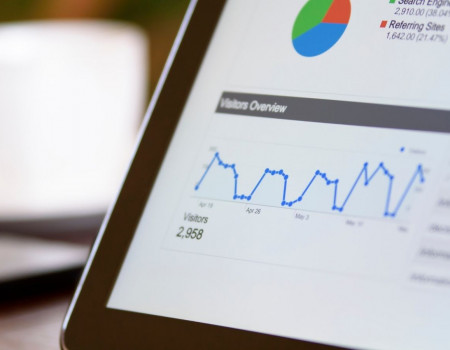A portfolio of business analytics solutions from SAP is truly impressive. The company offers a wide range of data analytics tools: Business Warehouse, Analytics Cloud, Lumira, Business Objects… But which tools you need?
To make it easier for you to determine that, we prepared a comprehensive list of SAP software, with a short explanation of their goals and intended use.
Let us introduce you to the world of SAP Business Intelligence – a package of software that helps you transform data into business knowledge. With the right choice of tools, you will be able to understand your company’s problems and opportunities and react in time in every situation.
SAP Business Warehouse
A data warehouse is a tool that allows you to store, modify and consolidate data from different systems to prepare them for reporting tools. If you are using an ERP system, usually you cannot compare data from different modules, for example: controlling and finances. A data warehouse makes it possible and lets you analyse your company’s situation in a comprehensive, more informed way.
You can choose from SAP BW/4HANA and SAP BW on HANA. In those names, HANA means an in-memory database HANA, a powerful product of SAP.
SAP BW on HANA is a warehouse using the HANA database. In the past, SAP BW could be used with different databases, like Oracle. HANA is much faster and better equipped for performing analytical tasks, so today this is the first choice. However, SAP BW on HANA will not be supported after 2027 – which means after this date, there will be no more updates or new options.
SAP BW/4HANA is a warehouse that was designed from the very beginning to draw all the advantages from the HANA database. Most operations were pushed to the database, so the application works much faster, has much greater efficiency in generating reports and data processing, reduces ABAP coding effort, and enables much simpler maintenance of the architecture.
You need SAP Business Warehouse to analyse the data that is dispersed among many systems or databases. The tool is a “single point of truth”, a central place where data is consolidated.
SAP Business Objects
This is the package of six solutions, answering the different needs of your company. Some of the products will not be supported soon, some will merge with others, so it is important to understand what you can expect from Business Objects – today and in the future.
Currently, SAP Business Objects contains six tools:
- Web Intelligence,
- Crystal Reports,
- SAP Lumira,
- SAP Business Objects Dashboards (formerly known as Xcelsius),
- Query as a Web Service (QaaWS),
- SAP BusinessObjects Explorer.
Web Intelligence, Crystal Reports and Lumira are three products that will still be developed and supported by SAP. Some of the functionalities of other products will be introduced into those three solutions, some – into other SAP data analytics products. Web Intelligence and Crystal Reports are going to be the two main parts of Business Objects. Despite being a part of the package, SAP Lumira is often used as a standalone solution and is being developed as such. Because of that, we will focus on describing SAP Business Objects functionalities through Web Intelligence and Crystal Reports, and take SAP Lumira as a standalone product.
SAP Business Objects platform is used to create reports and dashboards, and to access data from data warehouses and databases. Users can join or combine tables with all the data, no matter its source. But the main advantage is the fact that creating queries and reports is simplified in the tool, so end-users without technical knowledge of databases can use the platform without support from the IT department.
Web Intelligence is a tool available through a web browser – as such, you must be online to use it. Crystal Reports is a product used on-premise, but you have to be online to fetch data from the system. You have dedicated desktop application for CR, so using it gives you the best possible reporting user experience delivered by pixel-perfect dashboards. As an on-premise solution, Crystal Reports allow you to create a bit more advanced reports – but do not let that make you think the reports in Web Intelligence are basic. Both of the solutions offer high-quality reports.
You need SAP Business Objects when you want to make it possible for your employees to create reports and compare the data from different sources. The platform can be used by end-users that have little technical knowledge.
SAP Lumira
This tool can be used both as a part of SAP Business Objects package and as a standalone solution. With it, you can analyse the data and create complex reports.
Lumira is built on two applications. First, Lumira Discovery, lets you Discover and explore data from different data sources, make simple queries and draw conclusions based on data analysis. Next app, Lumira Designer, is a tool for creating analytical applications and dashboards. Lumira Designer allows developers to add their own designed buttons, widgets, sliders and maintain logic for them using Javascript based code. As a result, you can create very complex reports for your company.
If you need a tool that allows you to create both simple reports and complicated, complex analytical applications, choose SAP Lumira. Both end-users and advanced technically employees will be able to draw advantages from this solution.
SAP BI-IP
SAP Business Intelligence – Integrated Planning, is an engine based add-on. It is used for planning – on every level of the company, and in every department.
With BI-IP, you can implement a planning process, e.g. for this year’s budget or sales, for expected margins after a marketing campaign, for controlling processes and so on. Thanks to distribution function, with one tool you can create a general plan, and then push it to the lower levels of the company, so managers can create their plans based on the strategic goal or estimated overall budget. Then it can be pushed even lower, to team leaders, so they can create their assumptions within the limits of the higher-tier plan. The tool allows you to create any detailed forecast, in which every deviation will be immediately visible – and hence possible to correct.
The plans are created based on data you upload to BI-IP. How can you do that? For example, with Analysis For Microsoft Office, a plugin for Microsoft Excel.
The tool gives you a great opportunity to create complex, comprehensive plans and models. However, there are a few downsides here. The most important one is: SAP-IP will become a part of SAP BPC 11.0. All functionalities of the product will be available, but only as a part of SAP BPC, not standalone. What is more, this tool is not designed for end-users. To create queries, you need to understand how SAP BW is working, which means having technical knowledge about databases.
An advantage of BI-IP is that it can be used without a standalone data warehouse. If you use SAP S/4HANA or older version of SAP ERP, you already have an access to SAP BW (named: Embedded BW) – so you can use BI-IP on the same system. There is a disadvantage to this approach: Embedded BW uses S/4HANA’s computing and memory resources, so when you process a large amount of data, it can negatively affect the ERP system’s performance. However – if you already have SAP BW on HANA – you are ready to draw all benefits from BI-IP.
Use SAP BI-IP if you need a tool for planning for SAP ERP system or SAP BW, on every level of the company – from the board to the team leaders. However, remember that this software is not meant for end-users: to use it, you need a technical knowledge on SAP BW.
SAP BPC
SAP Business Planning and Consolidation, as its name suggest, is an application designed for planning. It has the same functions as SAP BI-IP: it lets you create plans for any department in the company and for its every level. There are a few important differences between those two tools though.
First, SAP BPC is an application, while SAP BI-IP – an engine. BPC is really based on the IP engine, but because it is an application, it facilitates the creation and management of planning processes by offering functionalities built directly into them. In short, SAP BPC facilitates the process of creating and managing, but as a result, lacks full customisation options. SAP BI-IP is full customizable, but offers no support when creating anything: everything needs to be created from scratch there.
Secondly, SAP BPC can be used with platforms other than SAP ones (e.g.: Microsoft SQL Server). Next, the queries can be created via the internet browser. There are many predefined functions, and because of them, after additional training, even end-users without technical knowledge will be able to use them.
Finally, this tool can be integrated with other SAP products, for example, SAP Analytics Cloud. As a front-end solution, SAP Analytics Cloud would be used as an interface, while all calculations, processes and data came from SAP BPC.
If you search for planning tool for users without a vast technical knowledge, and you are using other platforms than only SAP ones, choose SAP BPC.
SAP Data Services
It is a supporting tool whose function is to enable the transfer of data from one system to another.
It is an ETL tool, that allows sending data between two different systems. In contrary to a data warehouse, it does not store data, only transfers it. You might be asking: why then would I consider this tool instead of SAP BW? The reason is: to transfer data from SAP BW to other, not-SAP system, the data has to go through many different processes. Data Services, as an ETL tool, can do it much faster and more efficient.
As such, SAP Data Services does not have many functions – but if you need it for this specific task, it performs it very well.
If you need to transfer data between various systems fast and efficient, and you do not want or cannot use a data warehouse, decide on SAP Data Services.
SAP Analytics Cloud
Another front-end tool, SAP Analytics Cloud is one of those analytical tools that SAP focuses on the most. Within this solution, you will find three huge components: Business Intelligence for processing data, planning and predictive analysis. What is more, it can also be a database – you can load data to it from multiple external sources and transform it in any desired way. The whole solution is based on the cloud, as the name indicates – which means you can access it via internet browser from any device.
SAP Analytics Cloud is accessible and does not require technical knowledge from the users. The tool is designed to make analysing as easy as possible – this is also provided by machine learing. You can, for example, type your questions (e.g. “what was our best selling product in 2018?“) into a search bar, and the software not only show you a report or model that has needed data but also formulates the answer.
A huge bonus is machine learning technology that SAP Analytics Cloud takes advantage of. Machine learning helps you discover relationships between data and detect anomalies. What is more, training predictive models makes them more and more accurate, and very efficient in predicting outcomes of even small changes.
If you are searching all-in-one tool that lets you create a visualisation, perform predictive analysis and plan your company’s next actions, choose SAP Analytics Cloud. It is an especially good choice if you do not have a vast technical knowledge.
Summary
To answer which one of all SAP analytics tools is useful for your company, you first have to think about two things:
First: Can your employees work with advanced tools? Is the IT department capable of supporting end-users in their everyday work?
Second: What are your needs at this moment? Are you searching for planning tool, for a software to store and process the data, or for a program for creating data models and predictive analysis? Should you have one, specialized tool, or rather a package of different, more versatile solutions?
Knowing that you will be able to choose between complex packages and specialized tools, and between advanced and easy-to-learn software. However, if you want to ask for advice, or if your needs cannot be categorized like that – then use the chatbot and ask our consultants for help.
The material was created in cooperation with Damian Wawrzyniak, Senior SAP BI Consultant.





